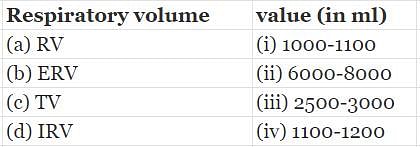Test: Breathing & Exchange of Gases-2 - NEET MCQ
20 Questions MCQ Test Biology Class 11 - Test: Breathing & Exchange of Gases-2
Which one of the following is wrong statement with respect to the functions of respiratory system?
The principle of exchange of gases at the lungs is :
| 1 Crore+ students have signed up on EduRev. Have you? Download the App |
The regulatory centres for respiration are located in :
In CNS, regulation of respiratory rhythm during normal breathing is largely dependent upon :
Respiration in insects is direct due to exchange of gases
Read the following statements :
i. The affinity of Hb for CO is 200 to 250 times more than its affinity for oxygen therefore CO competes with oxygen for binding to Hb.
ii. The result of this binding are a shift of oxygen-hemoglobin dissociation curve to the left and its alteration to a more hyperbolic shape.
RBCs and muscle cells carry out anaerobic respiration, but :
i. RBCs are permanently anaerobic and muscle cells are temporarily anaerobic
ii. RBCs are temporarily anaerobic and muscle cells are permanently anaerobic
iii. Muscle cells lack mitochondria.
What happens to the respiratory rate when the carbon dioxide concentration in the blood increases?
Which enzyme plays a crucial role in facilitating the reaction between CO2 and haemoglobin?
A person living at sea level has approximately 5 million red blood cells per cubic millimeter of blood. In comparison, a person living at 5400 meters has about 8 million red blood cells. Because of the high altitude
The given graph shows O2 consumption and ventilation during exercise so we can infer from this graph :
i. During exercise, oxygen consumption rate in our body increases.
ii. Neural stimulus allows abdominal muscles , which are a kind of smooth muscle to contract to facilitate ventilation while exercising.
iii. Increase in ventilation during exercise prevents large changes in the partial pressure of O2 or CO2
iv. The overall impact is breathing rate increases.
The exchange of gases in :
i. the alveoli that lowers the pO2 of blood and raises its pCO2 is external respiration
ii. the tissues that lowers the pCO2 of blood and raises its pO2 is internal respiration
Read the following :
i. During chloride shift , the chloride ions diffuse into the red blood cells from plasma.
ii. Chloride shift, helps to maintain ionic balance and chemical neutrality.
iii. Chloride shift occurs during transport of CO2 .
An increase in lung ventilation rate is caused by which of the following conditions?
If TLC is 5500ml, IRV is 2950ml, ERV is 900ml and TV is 500ml then what will be value of RV ?
The correct sequence of respiration is
i) Breathing in oxygen
ii) Transportation of gases by the blood
iii) Diffusion of gases between blood and tissues
iv) Diffusion of gases across alveolar membrane
v) Using of oxygen and releasing of carbondioxide
What is the relationship between pO2 and the binding of CO2 to haemoglobin in tissues?
|
182 videos|365 docs|153 tests
|













